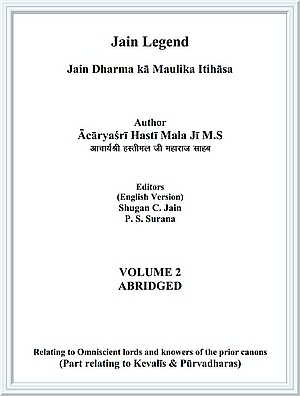(Daśa Pūrvadhara)
The span of time from nirvāṇa of Lord Mahāvīra to 62 years is considered as Kevalī era by some of the acclaimed scriptures of Digambara sect, whereas some extend it up to 64 years.
After the stipulated omniscient - Indrabhūti, Sudharmā and Jambū Swāmī, even the Digambara sect named five Śrutakevalīs, who were scholars in Dwādaśāṃgī and the fourteen Pūrvas. However there are minor differences in the names and their tenure between both the schools. As far as the fifth Śrutakevalī, Ācārya Bhadrabāhu is considered both of the schools have a unanimous opinion.
Śvetāmbara school of thought mentioned the names of Ārya Prabhava, Ārya Sayyaṃbhava, Ārya Yaśobhadra, Ārya Saṃbhūtavijaya and Ārya Bhadrabāhu as Śrutakevalīs and expressed their total tenure as 106 years, whereas Digambara school of thought gives out the names of Viṣṇu, Nandimitra, Aparājita, Govardhana and Bhadrabāhu as Śrutakevalīs and their total tenure as 100 years.
The introduction of the ten Pūrvadharas as per Śvetāmbara sect is already given. Kevalī era extends to 64 years, Śrutakevalī era 106 years and Daśa Pūrvadhara era for 414 years; altogether the aggregate years are 584. Thus according to the Śvetāmbara School, the knowledge of the ten Pūrvas lasted up to 584 years.
But according to Digambara sect, Kevalī era stretched for 62 years, Śrutakevalī era for 100 years and Daśa Pūrvadhara era for 183 years. Thus according to them, the knowledge of the ten Pūrvas lasted up to V.N. 345 only. The list of the ten Pūrvadharas, according to Digambara School is as follows:
- Viśākhācārya
- Proṣṭhila
- Kṣatriya
- Jaya
- Nāgasena
- Siddhārtha
- Dhṛtiṣeṇa
- Vijaya
- Buddhila
- Gaṃgadeva
- Dharmasena
Ācārya Guṇabhadra describes these eleven ācāryas as scholars and also as Daśa Pūrvadharas and an expert of the twelve Aṃgas.
Contemporary political scenario of
Ācārya Nagahasti & Ācārya Vajra
It is already mentioned that king Vikramāditya ruled the country from V.N. 470 to 530. Under his reign, India became powerful, prosperous and attained progress politically, financially, socially, intellectually & militarily. He had a huge and powerful standing army. Even in the regime of his son Vikramasena, who inherited the throne after him, the country remained powerful and prosperous. But during the last phase of his reign, once again Śakas revolted and attacked some regions. Ultimately, they established their authority over some regions in the northwest frontier. After the death of Vikramasena, the pressure of attacks from the Śakas went on increasing.
 Acharya Hasti Mala
Acharya Hasti Mala
